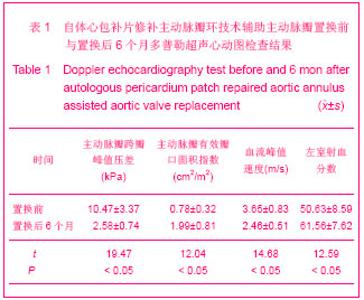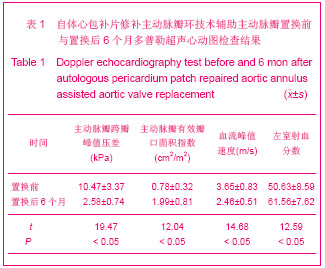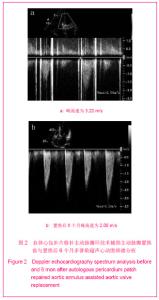Chinese Journal of Tissue Engineering Research ›› 2013, Vol. 17 ›› Issue (5): 761-768.doi: 10.3969/j.issn.2095-4344.2013.05.001
Autologous pericardium patch repairs the aortic annulus to assist aortic valve replacement
Xia Bing, Wen Bing, Xu Hua-shan, Fu Guo-wei, Zhao Wen-zeng
- Department of Cardiovascular Surgery, the First Affiliated Hospital of Zhengzhou University,Zhengzhou 450052, Henan Province, China
-
Received:2012-12-02Revised:2013-01-16Online:2013-01-29Published:2013-01-29 -
Contact:Zhao Wen-zeng, Master, Chief physician, Professor, Doctoral supervisor, Department of Cardiovascular Surgery, the First Affiliated Hospital of Zhengzhou University, Zhengzhou 450052, Henan Province, China zhwz@zzu.edu.cn -
About author:Xia Bing★, Studying for master’s degree, Department of Cardiovascular Surgery, the First Affiliated Hospital of Zhengzhou University, Zhengzhou 450052, Henan Province, China 260173980@qq.com
CLC Number:
Cite this article
Xia Bing, Wen Bing, Xu Hua-shan, Fu Guo-wei, Zhao Wen-zeng. Autologous pericardium patch repairs the aortic annulus to assist aortic valve replacement[J]. Chinese Journal of Tissue Engineering Research, 2013, 17(5): 761-768.
share this article

2.1 术中和围手术期情况 术中主动脉阻断时间为52-88(63.0±18.1) min,体外循环时间为78-122 (102.6±25.1) min。全部患者均顺利植入19#-23#人工主动脉瓣。术后1例患者出现急性肾功能衰竭,经床旁血透治疗后治愈。其余无严重手术并发症。无手术和住院死亡病例。 2.2 随访6个月时患者心功能情况 42例患者均获得随访,随访时间6个月,无失访情况,随访中无患者死亡情况,所有患者生活质量均有所改善。术后6个月随访,心功能纽约心脏病协会分级(NYHA)Ⅰ级25例,Ⅱ级7例。 2.3 随访6个月患者症状及体征改善情况 置换后6个月随访,所有患者均无呼吸困难及心绞痛、晕厥、充血性心力衰竭等症状的发生,均可进行一般的生活活动。体格检查:听诊原有心脏杂音消失,可闻及胸骨右缘第二肋间正常机械瓣开瓣音。 2.4 多普勒超声心动图检测结果 置换后6个月心脏超声显示人工瓣膜假体功能良好,均未发现人工主动脉瓣膜假体瓣周漏,偶可见正常机械瓣开关瓣血液细小分流。 置换前与置换后6个月多普勒超声心动图测量结果对比:主动脉瓣跨瓣峰值压差(△P)、主动脉瓣有效瓣口面积指数(EOAI)、血流峰值速度(PV)、左室射血分数(EF%)与术前各测量结果进行配对t 检验,所得P值均< 0.05,差异有显著性意义,较术前各项结果均有明显改善,见表1。"

| [1] Zhang JQ,Lu JZ,Xiao MD,et al. Zhongguo Xinxueguanbing Yanjiu Zazhi. 2008;6(9):686-687.张建卿,卢继忠,肖明第,等.主动脉瓣环切除重建术在特殊换瓣患者中的应用探讨[J].中国心血管病研究杂志,2008,6(9):686-687.[2] Zhang JQ,Li WB,Xiao MD,et al.Zhonghua Shiyong Zhenduan yu Zhiliao Zazhi. 2008;22(9): 696-697.张建卿,李温斌,肖明弟,等.冠脉开口移植及主动脉瓣环切除术在主动脉置换术中的应用[J].中华实用诊断与治疗杂志,2008, 22(9): 696-697.[3] Pan WZ,Zhou DX,Ge JB. Zhonghua Xinxueguanbing Zazhi. 2012;40(2):166-168.潘文志,周达新,葛均波. 钙化性主动脉瓣疾病基础和临床研究进展[J].中华心血管病杂志,2012,40(2):166-168.[4] Jiang JZ. Zhongguo Laonian Baojian Yixue. 2005;3(2):10-12.江金芝.老年性主动脉瓣钙化危险因素研究[J].中国老年保健医学,2005,3(2):10-12.[5] Fraund S, Pethig K, Wahlers T,et al. ON-X bileaflet valve in aortic position--early experience shows an improved hemodynamic profile.Thorac Cardiovasc Surg. 1998;46(5): 293-297.[6] Liu J,Zhao Q,Chen ZQ,et al. Zhongguo Linchuang Yixue. 2004;11(4):557-558.刘俊,赵强,陈志强,等.On-X机械主动脉瓣膜临床血流动力学观察[J].中国临床医学,2004,11(4):557-558.[7] Shen HY. Zhongguo Zuzhi Gongcheng Yanjiu yu Linchuang Kangfu. 2009;13(26):5141-5144.申红亚.人工瓣膜置换对血流动力学影响的系统分析[J].中国组织工程研究与临床康复,2009,13(26):5141-5144.[8] Zhang HB,Han J,Bai T,et al. Xinfei Xueguanbing Zazhi. 2008; 27(1):4-7.张海波, 韩杰,白涛,等.小左心室和大左心室患者进行相同机械二尖瓣置换术后围手术期血流动力学研究[J].心肺血管病杂志, 2008,27(1):4-7. [9] Wang ZN,He B. Shanghai: Second Military Medical University Press, 2009:3-18.约翰•霍普金斯医院.心脏外科围术期处理手册[M].2版.王志农,何斌,译.上海:第二军医大学出版社,2009:3-18.[10] Feng XY,Wang HC,Jia GL,et al. Disi Junyi Daxue Xuebao. 2001;22(13):1232.冯旭阳,王海昌,贾国良,等.风心病患者瓣膜置换术前冠状动脉造影检查的意义[J].第四军医大学学报,2001,22(13):1232.[11] Wang HT,Yang SQ,Zhang H. Shandong Yiyao. 2008;48(47): 66-67.王宏涛,杨书强,张华.467例心脏瓣膜置换术患者围手术期的处理[J].山东医药,2008,48(47):66-67.[12] Chen CH. Zhongguo Shiyong Huli Zazhi. 2009;25(30):30-31.陈朝红.心脏瓣膜置换术后常见并发症的观察及护理[J].中国实用护理杂志,2009,25(30):30-31.[13] Huang YW,Zhu ZJ. Xiandai Shiyong Yixue. 2008;20(12): 919-922.黄元伟,朱志军.心力衰竭的临床评估与治疗[J].现代实用医学, 2008,20(12):919-922.[14] Huang J. Xinxueguanbingxue Jinzhan. 2012;33(1):1-5.黄峻.慢性心力衰竭诊断和治疗2012:现状和进步[J].心血管病学进展,2012,33(1):1-5.[15] 中华医学会心血管分会,中华心血管病杂志编辑委员会.慢性心力衰竭诊断治疗指南[J].中华心血管杂志,2007,35(12): 1076-1095.[16] Bauset R, Dagenais F. Double valve replacement through an aorto-annulo-atriotomy using an aortic-valved graft in a mitral position.Ann Thorac Surg. 2002;73(6):1986-1987.[17] Peterson MD, Borger MA, Feindel CM,et al. Aortic annular enlargement during aortic valve replacement: improving results with time. Ann Thorac Surg. 2007;83(6): 2044-2049.[18] Hanayama N, Christakis GT, Mallidi HR,et al. Patient prosthesis mismatch is rare after aortic valve replacement: valve size may be irrelevant. Ann Thorac Surg. 2002;73(6): 1822-1829.[19] Molina JE. Enlargement of the aortic annulus using a double-patch technique: a safe and effective method. Ann Thorac Surg. 2002;73(2):667-670.[20] Zhu YB,Zhu B,Yang M,et al.Yixue Yanjiu Zazhi. 2012; 41(5) : 149-152.朱亚彬,朱兵,杨岷,等.Konno法和改良Manougnian法行主动脉瓣置换术的临床结果[J]. 医学研究杂志, 2012, 41(5) :149-152.[21] Huang Y,Xiang JS,Yang ZJ,et al. Zhongguo Xiandai Shoushuxue Zazhi. 2010;14(5):347-349.黄勇,向加树,杨智杰,等. Manouguian法瓣环增宽加主动脉瓣置换术治疗成人小主动脉瓣环[J].中国现代手术学杂志, 2010, 14(5): 347-349.[22] Zhu P,Wu RB,Zhuang J,et al. Nanfang Yike Daxue Xuebao. 2007;27(7):1125-1126.朱平,吴若彬,庄建,等.小主动脉瓣环扩大并主动脉瓣置换术18例报告[J].南方医科大学学报, 2007,27(7):1125-1126.[23] Zhao GF. Yishi Jinxiu Zazhi. 2005;28(10):40-42.赵国芳.改良Nicks法行小主动脉瓣环扩大及主动脉瓣置换术[J].医师进修杂志,2005,28(10):40-42.[24] Song SQ,Li WB,Chen BT,et al. Xinfei Xueguanbing Zazhi. 2009;28(1): 21-23.宋士秋,李温斌,陈宝田,等. 小瓣环主动脉瓣置换并主动脉瓣环扩大术的近中期结果[J].心肺血管病杂志, 2009, 28(1): 21-23.[25] Li T,Huang JH,Wu QZ,et al. Zhonghua Xiongxin Xueguan Waike Zazhi. 2004;20(4):238.李韬,黄健宏,吴全忠,等.改良Nicks法瓣环扩大联合环上瓣置入治疗小瓣环主动脉瓣病变[J].中华胸心血管外科杂志, 2004, 20(4):238.[26] Han L,Xu ZY,Zou LJ,et al. Zhonghua Xiongxinxueguan Waike Zazhi. 2011;27(2):90-92.韩林,徐志云,邹良建,等.瓣环结构重建的瓣膜置换手术[J].中华胸心血管外科杂志,2011,27(2):90-92.[27] Liu ZM, Roland Hetzer,Weng YG. Beijing:People’s Medical Publishing House. 2010:524-526.刘中民,Roland Hetzer,翁渝国.实用心脏外科学[M].北京:人民卫生出版社,2010:524-526.[28] Li XH,Xu ZY,Cao X. Shandong Yiyao. 2011;51(6):90-92.李先华,徐志云,曹翔.环上瓣植入与瓣环扩大在成人小主动脉瓣环换瓣术中的应用效果观察[J].山东医药,2011,51(6):90-92.[29] Chen M,Li YZ. Zhongguo Linchuang Yixue. 2008;15(1):39-42.陈铭,李颖则.小主动脉瓣环在手术中的处理[J].中国临床医学, 2008,15(1):39-42.[30] Gillinov AM, Blackstone EH, Alster JM,et al. The Carbomedics Top Hat supraannular aortic valve: a multicenter study. Ann Thorac Surg. 2003;75(4):1175-1180.[31] Ghosh P, Kumar S, Pandey S,et al. Small aortic annulus: a functional definition. Ann Thorac Cardiovasc Surg. 1998;4(5): 251-261.[32] Xu ZY,Tang H,Xu JB,et al. Zhongguo Xiongxinxueguan Waike Linchuang Zazhi. 2012;19(1):1-3.徐志云,唐昊,徐激斌,等.非原位主动脉瓣置换术治疗主动脉瓣环严重毁损性病变的方法与疗效[J].中国胸心血管外科临床杂志, 2012,19(1):1-3.[33] Sun HB. Zhongguo Yiyao Zhinan. 2012;10(28):133-134.孙红斌.小主动脉瓣环者接受机械瓣膜置换术后的远期疗效分析[J].中国医药指南,2012,10(28):133-134.[34] Li JY,Zhang JQ,Bo P,et al. Zhongguo Xiongxinxueguan Waike Linchuang Zazhi. 2008;15(5):329-332.李继勇,张健群,伯平,等.小主动脉瓣环患者机械瓣置换术后中期疗效分析[J].中国胸心血管外科临床杂志,2008,15(5):329-332. [35] Gao BT,Zheng JH,Liu YJ,et al. Shanghai Jiaotong Daxue Xuebao:Yixueban. 2011;31(9):1352-1354.高波涛,郑景浩,刘玉洁,等.自体心包补片在婴幼儿简单室间隔缺损修补中的应用[J].上海交通大学学报:医学版,2011,31(9): 1352-1354.[36] Liu JF. Beijing:Peking University Medical Press. 2009:29-30.刘锦纷.先天性心脏病外科综合治疗学[M].北京:北京大学医学出版社,2009:29-30.[37] Sun BP,Zhang ZW,Yu JG,et al. Zhonghua Xiongxinwaike Zazhi. 2011;27(6):354-356.孙柏平,张泽伟,俞建根,等.ASO术中自体心包重建肺动脉根部[J].中华胸心血管外科杂志,2011,27(6):354-356.[38] Xu J,Shu LL,Zhao WZ. Zhengzhou Daxue Xuebao:Yixueban. 2004;39(3):513-514.徐敬,舒礼良,赵文增.重症心脏瓣膜病外科治疗38例体会[J].郑州大学学报:医学版,2004,39(3):513-514.[39] Prifti E, Bonacchi M, Bernabei M, et al. Repair of complete atrioventricular septal defect with tetralogy of fallot: our experience and literature review.J Card Surg. 2004;19(2): 175-183.[40] Isomatsu Y, Shin'oka T, Aoki M, et al. Establishing right ventricle-pulmonary artery continuity by autologous tissue: an alternative approach for prosthetic conduit repair.Ann Thorac Surg. 2004;78(1):173-180.[41] Bennink GB, Hitchcock FJ, Molenschot M, et al. Aneurysmal pericardial patch producing right ventricular inflow obstruction. Ann Thorac Surg. 2001;71(4):1346-1347.[42] D'Andrilli A, Ibrahim M, Venuta F,et al. Glutaraldehyde preserved autologous pericardium for patch reconstruction of the pulmonary artery and superior vena cava.Ann Thorac Surg. 2005;80(1):357-358.[43] Qian XM,Zhong SZ. Nanfang Yike Daxue Xuebao. 2009; 29(10): 2055-2058.钱希明,钟世镇.主动脉瓣不匹配对老年病人术后生活质量的影响[J].南方医科大学学报,2009,29(10):2055-2058.[44] Yu T,Xie DX,Wang YZ,et al. Zhongguo Xiongxinxueguan Waike Linchuang Zazhi. 2008;15(3):230-232.于涛,谢定雄,王延震,等.成人小主动脉瓣环患者的心瓣膜置换术[J].中国胸心血管外科临床杂志,2008,15(3):230-232.[45] Chen JW,Luo RF,Zhong HQ,et al. Zhonghua Quanke Yixue. 2009;7(2):132-133.陈景伟,罗瑞芳,钟焕清,等.主动脉瓣环扩大术在主动脉瓣置换术中的应用[J].中华全科医学,2009,7(2):132-133.[46] Wu Z,Wang DJ,Li J,et al. Zhonghua Xiongxinxueguan Waike Zazhi. 2010;26(6):374-376.武忠,王东进,李捷,等.主动脉瓣置换术后人工心脏瓣膜-病人不匹配现象[J].中华胸心血管外科杂志,2010,26(6):374-376.[47] Walther T, Rastan A, Falk V,et al. Patient prosthesis mismatch affects short- and long-term outcomes after aortic valve replacement.Eur J Cardiothorac Surg. 2006;30(1):15-19.[48] Moon MR, Pasque MK, Munfakh NA,et al. Prosthesis-patient mismatch after aortic valve replacement: impact of age and body size on late survival.Ann Thorac Surg. 2006;81(2): 481-488.[49] Nouette K, Richebé P, Calderon J,et al. Perioperative anticoagulation management for prosthetic heart valves.Ann Fr Anesth Reanim. 2005;24(6):621-631.[50] Li T,Cai ZJ,Liu WY,et al. Zhongguo Xiongxinxueguan Waike Linchuang Zazhi. 2006;13(3):197-198.李彤,蔡振杰,刘维永,等.生物瓣心瓣膜置换术后远期疗效[J].中国胸心血管外科临床杂志,2006,13(3):197-198.[51] Chu YL,Li L,Wu YY,et al. Zhongguo Xunhuan Zazhi. 2006; 21(2):140-142.褚衍林,李鲁,吴英渝,等.风湿性心脏瓣膜替换术后远期疗效观察[J].中国循环杂志,2006,21(2):140-142. |
| [1] | Yang Xin, Jin Zhe, Feng Xu, Lu Bing. The current situation of knowledge and attitudes towards organ, eye tissue, body donation of residents in Shenyang [J]. Chinese Journal of Tissue Engineering Research, 2021, 25(5): 779-784. |
| [2] |
Ma Chao, Wang Huishan, Han Jinsong, Yin Zongtao, Zhang Xiling.
Cardiac valve prosthesis implantation and surgical maze ablation for the treatment of valvular disease with atrial fibrillation [J]. Chinese Journal of Tissue Engineering Research, 2020, 24(28): 4580-4587. |
| [3] | Yin Yating, Zhang Aijun, Wang Hao, Wang Pingping, Li Jianhua, Wen Minmin, Jin Peisheng. Clinical application of autogenous adipose-derived stromal vascular fraction-assisted fat transplantation in the improvement of facial skin quality [J]. Chinese Journal of Tissue Engineering Research, 2019, 23(9): 1428-1433. |
| [4] | Yin Peiyong, Cui Xiaohong, Xiong Ting, Li Sufang, He Ximin. Efficacy of transcatheter aortic vavle repalcement and surgical aortic vavle replacement for aortic stenosis: a Meta analysis [J]. Chinese Journal of Tissue Engineering Research, 2019, 23(30): 4905-4912. |
| [5] | Cai Qiucheng, Fan Hongkai, Xiong Rihui, Jiang Yi. Intravenous administration of bone marrow mesenchymal stem cells protects liver function following fatty liver transplantation from donors after cardiac death [J]. Chinese Journal of Tissue Engineering Research, 2019, 23(17): 2625-2629. |
| [6] | Jiang Shanshan, Wang Feng, Yu Limei. Immunomodulatory properties of mesenchymal stem cells and their application in organ transplantation [J]. Chinese Journal of Tissue Engineering Research, 2019, 23(1): 103-109. |
| [7] | Liu Teng-fei, Zhou Jian-kang, Huang Tuan-jie, Xing Qu, Cheng Kang, Li Peng, Li Dong-peng, Yang Bo, Ma Shan-shan, Guan Fang-xia . MG53 protein protects against multiorgan ischemia/reperfusion injury: present and future [J]. Chinese Journal of Tissue Engineering Research, 2017, 21(20): 3248-3254. |
| [8] | Li Ling, Li Ning, Ai Zi-ye, Yao Ya-jun, Wei Wan-hui, He Wei-yang, Wang Yan-feng, Ye Qi-fa. Intra-patient variability of tacrolimus concentration in transplant recipients: a prognostic predictor post transplantation [J]. Chinese Journal of Tissue Engineering Research, 2016, 20(49): 7437-7422. |
| [9] | Lin Jing-xia, Su Fan, Luo Hong-shan. Transfusion of blood components in liver transplantation and abdominal multiple organ transplantation [J]. Chinese Journal of Tissue Engineering Research, 2016, 20(33): 4957-4962. |
| [10] | Dong Jian-hui, Li Hai-bin, Sun Xu-yong, Qin Ke, Liao Ji-xiang, Li Mei-si, Huang Xiao-dan, Huang Chen, Huang Ying, Cao Song, Gao Zhao, Li Zhuang-jiang, Nie Feng, Yang Jian-jun. Clinical effects of renal transplantation with kidneys from donors dying of organophosphate poisoning [J]. Chinese Journal of Tissue Engineering Research, 2016, 20(29): 4311-4318. |
| [11] | Zhang Wen-xin, Teng Sha, Peng Xiao, Lin Xiao-hong, Liu Hong-xia. Systematic review of the effects of education on medical students’ knowledge and attitudes toward organ donation and transplantation [J]. Chinese Journal of Tissue Engineering Research, 2015, 19(5): 810-814. |
| [12] | Hu Xiao-yan, Wang Yan-feng, Ye Qi-fa, Chen Zhi-quan, Fan Xiao-li, Guo Yi, Li Ning. Effects of hypothermic machine perfusion versus static cold storage of kidney allografts on transplant outcomes: a Meta-analysis [J]. Chinese Journal of Tissue Engineering Research, 2015, 19(42): 6882-6888. |
| [13] | Gong Li-yuan, Huang Wei, Chen Jian-ming, Lin Yang-yuan. Application value of echocardiography in establishing rabbit models of diastolic heart failure [J]. Chinese Journal of Tissue Engineering Research, 2015, 19(40): 6418-6422. |
| [14] | Luo Wen-ting, Li Guang-sen, Wang Yuan-zheng, Tian Yan, Kang Wen, Meng Si-si. Correlation of brain natriuretic peptide and cardiac function of rabbits with hyperthyroid cardiomyopathy exhibiting different left ventricular geometries [J]. Chinese Journal of Tissue Engineering Research, 2015, 19(40): 6444-6449. |
| [15] | Zhang Li-ping, Bai Jian. Cytomegalovirus nosocomial infection following organ transplantation: detection and monitoring [J]. Chinese Journal of Tissue Engineering Research, 2015, 19(20): 3258-3263. |
| Viewed | ||||||
|
Full text |
|
|||||
|
Abstract |
|
|||||

